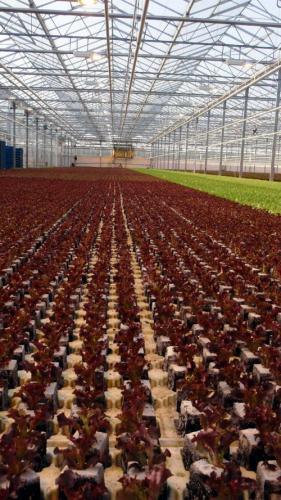Will greenhouse-grown vegetables replace ornamentals in U.S. greenhouses? – Part 2
Production expenses, challenges and regulation are important aspects to consider with a greenhouse-grown vegetables business.
In Part 1 of this series, Michigan State University Extension recommended that ornamental greenhouse growers who are considering also growing vegetables be aware of the differing labels between sprays for ornamentals and vegetable crops. Also, labor-intensive crops could impact the entire business, including profitability, due to increased expenses with health care. Greenhouse owners should consider the increased production expenses, production challenges and food safety regulations associated with growing vegetables.
 From the production standpoint, there are additional expenses with systems such as trellising, hydroponics and supplemental lighting. While the materials for trellising vine vegetable crops may be relatively inexpensive, the hours required to install the system can be around 300 for every half an acre of production. Hydroponic systems can be challenging for conventional growers and they can even double your costs per square foot of production. With respect to lighting, tomatoes, for example, require 10 to 12 mol∙m–2∙d–1 to be of minimal acceptable quality, which in the northern United States involves a significant amount of supplemental lighting. During the fruiting stages of vine vegetable crops, plants should be exposed to light intensities of at least 15 mol∙m-2∙d-1, but preferably more than 20 mol∙m-2∙d-1. When using such extensive supplemental lighting, CO2 injection systems are sometimes also implemented to continue to drive plant growth and fruit production.
From the production standpoint, there are additional expenses with systems such as trellising, hydroponics and supplemental lighting. While the materials for trellising vine vegetable crops may be relatively inexpensive, the hours required to install the system can be around 300 for every half an acre of production. Hydroponic systems can be challenging for conventional growers and they can even double your costs per square foot of production. With respect to lighting, tomatoes, for example, require 10 to 12 mol∙m–2∙d–1 to be of minimal acceptable quality, which in the northern United States involves a significant amount of supplemental lighting. During the fruiting stages of vine vegetable crops, plants should be exposed to light intensities of at least 15 mol∙m-2∙d-1, but preferably more than 20 mol∙m-2∙d-1. When using such extensive supplemental lighting, CO2 injection systems are sometimes also implemented to continue to drive plant growth and fruit production.
Photo: Lettuce production with supplemental lighting. Photo credit: Kristin Getter, MSU
For general information on production systems for greenhouse tomatoes, read the University of Tennessee Agricultural Extension Service article “Commercial Tomato Greenhouse Production.” For a compilation of minimum daily light integral requirements for transplants of edible and ornamental species, take a look at Purdue Extension’s “Measuring Daily Light Integral in a Greenhouse.”
Another challenge with growing vegetable crops are micronutrient (boron, copper, iron, manganese, molybdenum and zinc) deficiencies. Especially in vegetables grown with hydroponics, the fertilizer regimen needs to be constantly monitored. Micronutrient deficiencies can be hard to distinguish from one another. A general guideline is boron, copper, iron, manganese and zinc deficiencies first appear at the top of the plant while molybdenum deficiency often affects the whole plant simultaneously. Greenhouse cucumbers are particularly vulnerable to boron deficiencies.
For more on boron deficiency in vegetables, see the MSU Extension article “Boron in vegetables: Not too little, not too much.” The pH of the soil and water should be monitored vigilantly by growers to prevent problems.
If a grower produces perennials or woody ornamentals, the facility is already being inspected by the Michigan Department of Agriculture and Rural Development (MDARD). A vegetable program may involve more governmental involvement such as going through a USDA certification process such as Good Agricultural Practices (GAP) or Good Handling Practices (GHP), or it may require a certification by a third party auditor. Before considering adding a vegetable crop, a grower should contact their potential buyer or broker about what certification program they require. If a USDA certification is required by a vegetable buyer, a grower may be asked for documentation regarding sanitation of employees and facilities, adding signage around the facility, and for water quality testing.
The GAP audit includes having separate, sanitized harvesting equipment and storage containers and clean, dry storage facilities among many other requirements. For Food Safety, Labeling and Licensing regulations, see Chapter 5 in “Growing Michigan’s Future.” To learn about becoming GAP/GHP certified, visit the USDA Grading, Certification and Verification website, the audit user’s guide and aduit verification checklist. Also, see the example of an audit from Primus Labs.
While there are many drawbacks to growing vegetables in the greenhouse, there may also be benefits to expanding into edible crops. The primary reason for ornamental growers to start producing vegetables is to generate profits during seasons where there is low demand for ornamentals, such as in late fall for those in the northern United States. Another advantage of vegetable production is that there may be slightly more tolerance for pest and disease problems affecting the leaves of vine vegetable plants where the fruit is the saleable product, such as tomatoes and cucumbers. Therefore, growers could use the opportunity to use more biological control agents and fewer pesticides.
In addition, edible products are not as reliant on aesthetics and innovation as ornamentals and may also have less volatile, tight target windows present with some ornamentals, such as poinsettias and Easter lilies. However, vegetable production businesses have their own marketing challenges, such as trying to get their produce to the market before their competitors. Greenhouse vegetable growers focusing on supplying local markets could implement a marketing campaign focused on vine-ripened produce and local foods. Vegetable businesses also avoid the almost universal concern among ornamental plant growers – whether or not the “millennial” generation, born between 1980 and 2000s, will be buying gardening products. As with any new venture, there are many challenges and opportunities to consider.



 Print
Print Email
Email


